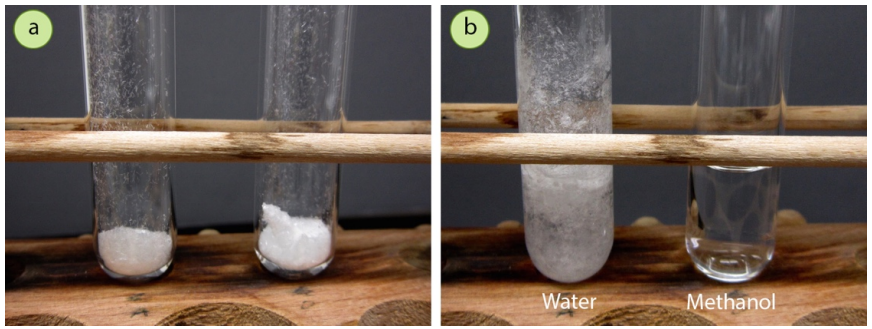3.3F: Mixed Solvents
- Page ID
- 95754
\( \newcommand{\vecs}[1]{\overset { \scriptstyle \rightharpoonup} {\mathbf{#1}} } \)
\( \newcommand{\vecd}[1]{\overset{-\!-\!\rightharpoonup}{\vphantom{a}\smash {#1}}} \)
\( \newcommand{\id}{\mathrm{id}}\) \( \newcommand{\Span}{\mathrm{span}}\)
( \newcommand{\kernel}{\mathrm{null}\,}\) \( \newcommand{\range}{\mathrm{range}\,}\)
\( \newcommand{\RealPart}{\mathrm{Re}}\) \( \newcommand{\ImaginaryPart}{\mathrm{Im}}\)
\( \newcommand{\Argument}{\mathrm{Arg}}\) \( \newcommand{\norm}[1]{\| #1 \|}\)
\( \newcommand{\inner}[2]{\langle #1, #2 \rangle}\)
\( \newcommand{\Span}{\mathrm{span}}\)
\( \newcommand{\id}{\mathrm{id}}\)
\( \newcommand{\Span}{\mathrm{span}}\)
\( \newcommand{\kernel}{\mathrm{null}\,}\)
\( \newcommand{\range}{\mathrm{range}\,}\)
\( \newcommand{\RealPart}{\mathrm{Re}}\)
\( \newcommand{\ImaginaryPart}{\mathrm{Im}}\)
\( \newcommand{\Argument}{\mathrm{Arg}}\)
\( \newcommand{\norm}[1]{\| #1 \|}\)
\( \newcommand{\inner}[2]{\langle #1, #2 \rangle}\)
\( \newcommand{\Span}{\mathrm{span}}\) \( \newcommand{\AA}{\unicode[.8,0]{x212B}}\)
\( \newcommand{\vectorA}[1]{\vec{#1}} % arrow\)
\( \newcommand{\vectorAt}[1]{\vec{\text{#1}}} % arrow\)
\( \newcommand{\vectorB}[1]{\overset { \scriptstyle \rightharpoonup} {\mathbf{#1}} } \)
\( \newcommand{\vectorC}[1]{\textbf{#1}} \)
\( \newcommand{\vectorD}[1]{\overrightarrow{#1}} \)
\( \newcommand{\vectorDt}[1]{\overrightarrow{\text{#1}}} \)
\( \newcommand{\vectE}[1]{\overset{-\!-\!\rightharpoonup}{\vphantom{a}\smash{\mathbf {#1}}}} \)
\( \newcommand{\vecs}[1]{\overset { \scriptstyle \rightharpoonup} {\mathbf{#1}} } \)
\( \newcommand{\vecd}[1]{\overset{-\!-\!\rightharpoonup}{\vphantom{a}\smash {#1}}} \)
When no single solvent can be found that meets all of the criteria for crystallization, it may be possible to use a mixed solvent. A pair of solvents is chosen: one in which the compound is soluble (called the "soluble solvent"), and one in which the compound is insoluble (called the "insoluble solvent"). The two solvents must be miscible in one another so that their solubility with one another does not limit the proportions used. Table 3.2 shows a list of common mixed solvents used in crystallization.
| Solvent Pair |
|---|
| Methanol / Water |
| Ethanol / Water |
| Acetone / Water |
| Methanol / Diethyl ether |
| Petroleum Ether (or hexanes) / Diethyl ether |
| Hexanes / Ethyl acetate |
To perform a crystallization using a mixed solvent, the solid to be crystallized is first dissolved in the minimum amount of hot "soluble solvent", then hot "insoluble solvent" is added dropwise until the solution becomes slightly cloudy. An additional small portion of hot soluble solvent is then added to clarify the solution, and the solution is set aside to slowly cool and crystallize. A diagram describing this process is shown in Figure 3.13.

Although this procedure can produce good results, when possible it is often best to use a single solvent for crystallization. As a mixed solvent is heated, the composition can change as the solvents evaporate at different rates, which can affect the solubility of the compound in the mixed solvent. Also, crystallizations from mixed solvents sometimes "oil out", where the dissolved compound comes out of solution above its melting point and forms a liquid instead of a solid.
To test a mixed solvent for crystallization, use the procedure that follows. This process is demonstrated by crystallizing trans-cinnamic acid from a mixed solvent of water and methanol (Figures 3.14 + 3.15).

- Use the previously described method (\(100 \: \text{mg}\) compound in \(3 \: \text{mL}\) solvent), to find a pair of solvents: one solvent in which the compound is soluble and one solvent in which the compound is insoluble (Figure 3.14). The solvents must be miscible with one another.
- Place a fresh \(100 \: \text{mg}\) of the solid to be crystallized in a test tube and add the "soluble solvent" dropwise while heating (with a steam bath or hot water bath, Figure 3.15a) until the solid just dissolves. The suspension should be immersed in the heat source after each drop, and some time should be allowed in between additions for the sometimes slow dissolving process.
- Add the "insoluble solvent" dropwise while heating until the solution becomes faintly cloudy (Figure 3.15c).
- Add the "soluble solvent" dropwise while heating until the solution is clarified (clear).
- Allow the system to cool to room temperature (Figure 3.15e), and then submerge in an ice bath for 10-20 minutes. If crystals return, the mixed solvent may work for the crystallization.



